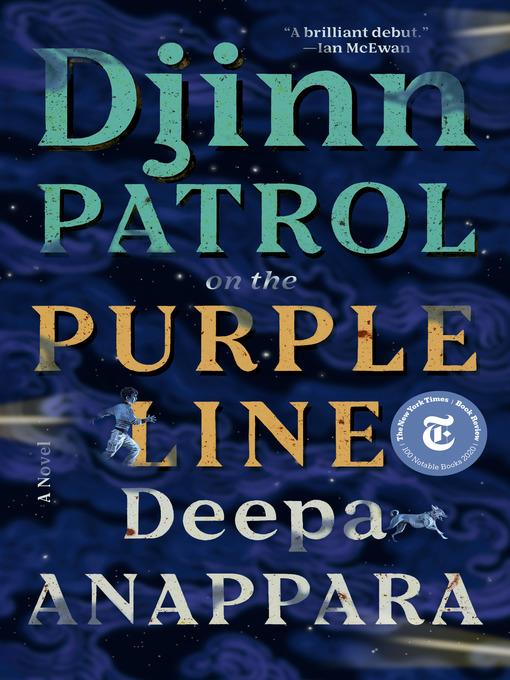
Djinn Patrol on the Purple Line
A Novel
- اطلاعات
- نقد و بررسی
- دیدگاه کاربران
نقد و بررسی

November 15, 2019
A debut novel by an Indian journalist tells a story full of humor, warmth, and heartbreak about children growing up in a Delhi shantytown. The narrator of most of this entrancing novel is 9-year-old Jai, who lives with his parents and older sister, Runu-Didi, in a basti, or slum, near the terminus of Delhi's Purple Line train tracks. When a school friend, a shy boy named Bahadur, disappears, Jai, an avid fan of TV crime shows, goes into action. He and his two best friends, a bright girl named Pari and a hardworking boy called Faiz, investigate. Young as they are, they know all too well how little regard the police have for people like them. Their basti is reminiscent of the Mumbai neighborhood depicted in Katherine Boo's Beyond the Beautiful Forevers: riven with grinding poverty yet bursting with life and always under threat of being bulldozed if the powers that be are unhappy. Jai has loving parents who work tirelessly to support their two kids, but he also knows how to chew a twig "to fool my tummy into thinking more food is on its way" when his next meal is uncertain. There's an almost Harry Potter-ish vibe to the relationship among the three intrepid kids, and Jai's voice is irresistible: funny, vivid, smart, and yet always believably a child's point of view. Anappara paints all of her characters, even the lost ones, with deep empathy, and her prose is winningly exuberant. But she also brings a journalist's eye to her story, one that is based on the shocking numbers of children who disappear from Indian cities every day. Jai wants to believe that Faiz is right when he says Bahadur was spirited away by a mythical djinn because the reality of his fate, and those of other children even closer to Jai, is too dreadful. Engaging characters, bright wit, and compelling storytelling make a tale that's bleak at its core and profoundly moving.
COPYRIGHT(2019) Kirkus Reviews, ALL RIGHTS RESERVED.

December 9, 2019
Anappara’s witty, resonant debut tracks a series of child disappearances from an Indian slum through the eyes of a nine-year-old boy. Jai lives with his friends Pari and Faiz in a slum next to a rubbish dump and the crowded Bhoot Bazaar, part of an unnamed city constantly beset by smog. An opening tale of a local benevolent ghost named Mental introduces the children’s shared magical thinking. When Jai and his friends learn that one of their classmates, Bahadur, has been missing for several days, Jai, a fan of police shows, decides that he and his friends will do their own detective work and find Bahadur since the police show little interest in the matter. Jai’s carefree nature lends a lighthearted tone to an increasingly grim tale as more children disappear and his team of sleuths find evidence pointing to a serial killer. His quest is aided by Pari’s voracious reading habits, which make her the better detective, and Faiz’s Muslim faith, which helps them stay on course when his community is blamed for the kidnappings. Interspersed with the trio’s investigation are single chapters devoted to each of the disappeared children. The prose perfectly captures all the characters’ youthful voices, complete with some Hindi and Urdu terms, whose meanings, if not immediately obvious, become clear with repetition. Anappara’s complex and moving tale showcases a strong talent.

November 1, 2019
Enamored of police reality shows, nine-year-old Jai decides to become a detective himself when a classmate goes missing from his impoverished urban Indian settlement. Hoping to solve the case, he enlists the aid of his two best friends, Faiz and Pari. Their mettle is tested when other children begin disappearing, and the corrupt local police ignore the situation. Faiz, a Muslim, is convinced that an evil djinn is responsible, while Pari pooh-poohs that notion and Jai equivocates. But if not a djinn, then who or what? Clearly something evil is at work as more and more children disappear; finally, even Jai's older sister becomes a victim. Jai bitterly decides he's not a detective after all, and even the solution of the mystery fails to bring him closure. The author has done an excellent job of telling her sometimes sad story in Jai's credible nine-year-old voice, and her treatment of her setting, with its ingrained social inequities, is a model of verisimilitude. Best, however, is her characterization, especially that of Jai, who comes to life on the page to live on in readers' memories.(Reprinted with permission of Booklist, copyright 2019, American Library Association.)




دیدگاه کاربران